Top News

August 11, 2011 Ryukyu Shimpo
University of Hawaii has published Living Spirit: Literature and Resurgence in Okinawa, an anthology of Okinawan contemporary literature, with the concept of it being unique literature, existing beyond the bounds of Japanese literature.
In cooperation with University of the Ryukyus, University of Hawaii presents a range of works of Okinawan literature including an Akutagawa Prize winning novel, poetry and Ryuka (Okinawan Lyrical Poetry), and drama.
The university has digitalized these works, publishing them on the Web, which makes them accessible to more than 4000 universities and research institutes all over the world.
The people involved expect that the publication of the anthology will allow Okinawan literature to be read worldwide, saying “Translation of these works into English makes it possible for Okinawan literature to be compared with other literary works in the world, letting the world know that Okinawan literature has universally appealing themes.”

At University of the Ryukyus in Nishihara Town, Katsunori Yamazato said, “Okinawan literature has aspects to it that go beyond Japanese literature.”
The anthology was co-edited by Frank Stewart, professor of University of Hawaii and Katsunori Yamazato, professor of University of the Ryukyus, who proposed the publication.
Twenty-four researchers from within Japan and the United States undertook the English translation of the works.
The anthology includes six novels including Mabuigumi by Shun Medoruma, The Paper Plane at the Empire State Building by Eikichi Nagado and Round-trip over the Ocean by Tami Sakiyama.
Among these works, Eiki Matayoshi’s The Wild Boar That George Gunned Down, which depicts an African American member of the military suffering from psychological problems before going to fight in the Vietnam War, stands out with regard to the theme of how the people of Okinawa view the United States, which treats Okinawa as a colony, and so has a significant impact on its readers.
In the category of contemporary poetry, the anthology includes works by Baku Yamanoguchi, Shinichi Kawamitsu and Mikio Yonaha, Tokuzo Makiminato and Ben Takara.
The anthology includes the dramatic version of Tatsuhiro Oshiro’s The Cocktail Party, the first Okinawan novel to be awarded the Akutagawa Prize. This work will be released in theaters in Hawaii in October.
Higa’s photographs capturing the festive rites of Okinawa and the Amami Islands feature in between each of these works.
The anthology includes The Omoro Soshi (a compilation of ancient poems and songs from Okinawa and the Amami Islands), Shushin Kaneiri (Possessed by Love, Thwarted by the Bell), a Kumi Odori by Tamagusuku Chokun and classic folk songs. It introduces overseas readers to the culture of Okinawa, which has been inherited from Ryukyu Dynasty.
Horrific memories of the Battle of Okinawa and the experience of being ruled by the U.S. military administration have had a significant influence on postwar Okinawa, and its unique history and cultural background have been constant and important themes in Okinawan literature.
Yamazato said, “The cultural heritage of Okinawa, which can be traced back to Omoro (Okinawan classic folk songs), sits outside the bounds of Japanese literature. Okinawan literature has grown significantly in the context of the oppression and the complicated political climate since the war. It is not simply one of the regional literatures of Japan, and has aspects to it that go beyond Japanese literature.”
(English Translation by T&CT, Mark Ealey)
Go To Japanese

August 12, 2011 Tsuyoshi Arakaki of Ryukyu Shimpo
Ahead of the 5th Worldwide Uchinanchu Festival to be held in October, the Next-Generation Project team, which is working on organizing a network for young people, has recently launched the “The World Youth Uchinanchu Network,” through which they call for younger uchinanchu to get in touch with each other through Facebook. Already some 765 people in their 20s and 30s living both within, and outside the prefecture have registered their membership on the network. They will discuss how to use it to develop exchange among younger uchinanchu around the world, with the key members acting as mediators.
Fifteen young people living in the prefecture manage the Next-Generation Project, in which they carry out public relations activities and workshops on the history of migration. They organized “The World Youth Uchinanchu Network” to broaden the relationship with the younger generation of uchinanchu.
About 200 of the people who have registered with the network are residents of foreign countries, including many second-generation or third-generation immigrants from Okinawa. They cannot raise the money to actually participate in the Worldwide Uchinanchu Festival, but they are very keen to create links with the same generation of young people in Okinawa. Since the exchange activities started, there have been some changes among Okinawan young people – some are beginning to learn the sanshin music instrument and how to speak uchinaguchi.
The executive director of the Next Generation Project 23-year-old Minami Tamamoto, said, “I think that the inheritance of identity can only be achieved through actual exchange, not just by citing it as an issue. We will do our best to expand such exchange.”
The project team has been sending message flags about the Uchinanchu Festival to young Okinawans and people of Okinawan descent in foreign countries who are unable to attend the Uchinanchu Festival. They have received a reply from Bolivia.
The Next Generation Project will hold the Minifestival for Uchinanchu, at 11:00am on August 28, at the students’ hall of the Ryukyu University.
(English Translation by T&CT, Mark Ealey)
Go To Japanese
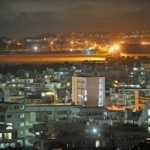
August 11, 2011 Ryukyu Shimpo
The U.S. military has transported radioactive waste and stored it in the U.S. Marine Corps Air Station Futenma. The waste is pollutants discharged during the decontamination work of “Operation Tomodachi” carried out by U.S. Forces as relief assistance for Fukushima Daiichi Nuclear Plant accident. An official of the Ministry of Foreign Affairs reported this to Okinawa Prefectural Government and to Ginowan City, on August 10.
According to Ginowan City Hall, an official of the Ministry of Foreign Affairs described it as low-level radioactive waste, and stated, “It is clothes and other things used in the decontamination work. They are stored in an airtight container.” The amount of such waste and the location where it is stored has not been divulged. With regard to the disposal of the waste, the official of the Ministry of Foreign Affairs said, “Those matters are still being considered” and regarding measures for its disposal, said, “We want to get data from the U.S. and then will provide detailed information.” It would seem that there was information on the radioactive waste storage in Futenma provided by the U.S. military to the Ministry in late June.
Shigeo Yamauchi, head of the Department for Military Base Affairs of Ginowan City, said, “It is a major issue that the Ministry of Foreign Affairs did not contact to us immediately when they received information about this nearly two months ago. We have not yet been given any details. We would like to get the relevant information and discuss what measures should be taken.”
A spokesperson for the Marines Corps in Okinawa told The Ryukyu Shimpo last month that eight CH-46 medium transport helicopters based at the Futenma Air Station had participated in the relief operation on mainland Japan for the Great East Japan Earthquake over a one-month period. After completing their mission, the helicopters were checked for radioactivity and were decontaminated at Atsugi Air Base. According to the spokesperson, the level of radiation had increased in the engines and other internal parts of six of the eight helicopters that returned to Futenma.
With regard to the decontamination, “It has been handled according to the requirements of the U.S. and Japanese governments,” and “the radiation is below the level set by the Pentagon,” the spokesperson explained.
Low-level radioactive waste has been also stored at U.S. Naval Base in Sasebo, in Nagasaki Prefecture, and U.S. Base and Maritime Self-Defense Force Yokosuka, in Kanagawa Prefecture.
(English Translation by T&CT, Mark Ealey)
Go To Japanese
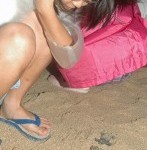
August 11, 2011 Ryukyu Shimpo
On the night of August 3, more than 100 loggerhead and green turtles hatched at the seaside near Ogimi Village. The baby turtles swam strongly out towards the sea, just as it became rough due to the approach of Typhoon No.9.
Many people came to observe, digging out the sand around the turtles to avoid them suffocating as seawater penetrated in. The baby turtles appeared one after another. The children cheered them on, saying, “How cute they are!” because the baby turtles are smaller than the palms of their hands.
Fifteen year-old Haato Kyan, an eighth-grade student of Okinawa Christian School International said, “I was moved to see turtles hatching for the first time. I’m sure that the baby turtles will give it their best shot out there in the stormy sea.”
Kunio Komesu, a member of the Japan Sea Turtle Association gave some advice for those observing turtles hatching, saying, “Because turtles naturally move towards light, to the greatest extent possible you should observe them by taking advantage of natural light such as moonlight. When using a torch, the sea should be behind you, not the shore.”
(English Translation by T&CT, Mark Ealey)
Go To Japanese

Go To Video
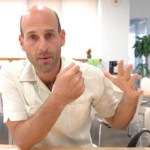
August 8, 2011 Ryukyu Shimpo
A written account by the students of American University in Washington who attended the lecture by Kevin Maher, former director of the State Department’s Office of Japan Affairs and former consul general in Okinawa Prefecture, exposed his derogatory remarks about the people of Okinawa.
David Vine, assistant professor at American University and the supervisor of the students in question, was interviewed by the Ryukyu Shimpo on August 7.
With regard to Maher’s remarks, in which he was quoted as saying “Okinawans are masters of manipulation and extortion of Tokyo,” Vine pointed out that discrimination, colonialism and a sense of superiority are behind his remarks, saying “I suspect that a number of people in the US government share this opinion.”
Vine claimed that this is a structural issue within the US government and is not confined to the former director of the State Department’s Office of Japan Affairs.
Vine analyzed the reasons behind Maher’s remarks, saying “The people in the US government have a sense of mastery over the people and the societies of other countries. There is a mix of factors behind Maher’s remarks, such as the aspect that has its roots in racial discrimination.”
Vine continued, “At the root of the problem is the history in which the United States used to occupy Okinawa. A limited number of US government officials ruled Okinawa as an occupier. There has not been much structural change in the reins of power that the US government has over the people of Okinawa even after its reversion to Japanese administration.”
Vine referred to the reaction American people to the issue of returning Futenma Air Station to Okinawa or relocating it to other areas either within or outside the prefecture, saying, “Few people in the United States know about the issue. Foreign news coverage in the US press is limited, which is a major problem.”
From the standpoint of studying U.S. military bases located in foreign countries, Vine claimed that such bases have much in common, saying, “U.S. military bases have negative repercussions for the country that hosts them. Noise pollution, crimes such as rape committed by U.S. military personnel, and environmental destruction can be seen.”
Vine visited Okinawa to participate in “Dialogue Under Occupation,” international conference (hosted by DUO Conference Executive Committee), which was held in Okinawa International University and Okinawa Christian University from August 6.
(English Translation by T&CT, Mark Ealey)
Go To Japanese
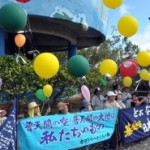
August 11, 2011 Ryukyu Shimpo
On August 10, three days before August 13, the date marking the seventh anniversary of a U.S. military helicopter crashing into a building at Okinawa International University, the anti-base women’s group “Kamado guwaa no tsudoi” which has been calling for the early reversion of the U.S. Marine Corps Futenma Air Station and its relocation outside the prefecture, released about 70 balloons at Kakazu Takadai Park and eight other locations around Futenma Air Station in Ginowan City as a protest to demand an end to U.S. military flights from the station.
This is the second time since April for the group to fly balloons as a protest against the flights out of Futenma.
The Facilities Administration Division of the Construction Department of Ginowan City Hall, Okinawa Defense Bureau and the Prefectural Police Department sent staff to watch over the protest rally that occurred in several parks in the city.
The Okinawa Defense Bureau told people not to enter the empty land adjacent to the fence of Futenma Air Station near the guide light in UeOjana. When they roped off this land, claiming that it belonged to the U.S. military, some of the participants in the rally, responded by saying, “It shouldn’t be forbidden to fly balloons on private property. Surely it is far more dangerous for both the U.S. and Japanese governments to allow military aircraft to fly over densely populated areas.”
While this was all happening, KC-130 aerial refueling airplanes and CH-46 helicopters repeatedly took off and landed at the station.
With regard to safety, a representative of the U.S. Marine Corps Public Affairs explained, “Those aircraft fly safely, staying far enough way from the balloons.”
Forty-five year-old Ushi Chinen, a member of “Kamado guwaa no tsudoi,” said, “More people seemed to be sympathetic to this protest rally than the previous one. We were praised by many people too, and I realized that expressing our thoughts without being heavy-handed helps make American people understand the issue.”
(English Translation by T&CT, Mark Ealey)
Go To Japanese

Go To Video
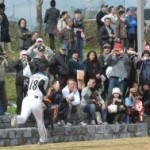
August 10, 2011 Ryukyu Shimpo
According to figures announced by Ryugin Research Institute Ltd. on August 9, professional baseball spring training camps brought 8.64 billion yen, a new record high, to Okinawa in 2011.
The fact that the Yomiuri Giants conducted their spring training camp in Okinawa for the first time and the popularity of Yuki Saito, who joined the Hokkaido Nippon-Ham Fighters, contributed to substantially increasing the number of spectators.
Although the figure fell below the 10.1 billion yen forecast by the Institute, it was still 3.154 billion yen more than the previous year, exceeding the previous high (6.2 billion yen in 2008) by about 2.4 billion yen.

The chart shows the economic impact generated by professional baseball spring training camps and the changing number of spectators.
Ten professional baseball teams including the Yomiuri Giants conducted training camps within the prefecture in February. Six of them also had their second teams conduct training camps in Okinawa.
A total of 253000 spectators watched games, including pre-season matches, during the period of the spring training camps, an increase of 82000 over the previous year.
Among the visitors to Okinawa during the period of the spring training camps, the number of people actually directly involved in professional baseball is estimated to have been about 1100, with about 2700 media people and about 43000 tourists.
The increasing numbers of news people including not only sports reporters but also entertainment reporters visiting the prefecture can be attributed to the nationwide popularity of Yuki Saito. The number is up by about 600 over the previous year.
The total direct expenditure on the spring training camps, including the cost of accommodation and training facilities amounted to 5.45 billion yen, up 2.024 billion yen on the previous year.
Besides the increase in expenditure on accommodation and souvenir purchases due to the larger number of spectators, expenditure on the use and upkeep of training facilities substantially increased because the Yomiuri Giants conducted their spring training camp in Okinawa.
In terms of the economic benefit for local industries, profits for the hotel industry amounted to 1.315 billion yen, those for the manufacturing industry were 1.178 billion yen, and the commerce industry 993 million yen.
Among the ten professional baseball teams, the Yomiuri Giants brought Okinawa the greatest benefit at 2.234 billion yen, followed by the Hokkaido Nippon-Ham Fighters at 1.615 billion yen.
The Institute concluded that, “The prefecture needs to create new business opportunities to take advantage of the training camps held by professional baseball teams.”
(English Translation by T&CT, Mark Ealey)
Go To Japanese

August 9, 2011 Masaaki Umeda of Ryukyu Shimpo
The total number of multiple-entry visas issued since July for Chinese tourists on the condition of at least one night stay in Okinawa has exceeded 1000. According to the Ministry of Foreign Affairs, 748 multiple entry visas were issued in July, a 15-times increase over the 50 ordinary individual tourist visas issued last July. As of August 5, 1021 multiple entry visas have been issued.
Because one visa allows an entire family to enter Japan, the number of individual tourists visiting Okinawa is expected to swell beyond the number of visas issued. There has been an increase in inquiries from overseas to the local agencies including questions about the possibility of charter flights from all over China. A local travel company employee said, “More Chinese tourists are visiting than we thought would be the case,” and an official of the Foreign Ministry stated, “This is a good start.”
A five to six thousand yen room rate per night is the standard according to the travel agency responsible for looking after Chinese tourists in Okinawa. In some cases as many as six family members have visited on one visa. With regard to the length of the stay, on average tourists visiting Okinawa on direct flights from China usually stay for three or four nights to enjoy the sights. In the case of travel through a domestic airport, they tend to visit Okinawa via Tokyo, Osaka, stay one night stay here, and the next day they leave the prefecture.
A person from the travel company predicts, “Quite separate to it being the holiday season, the number of Chinese tourists to visit Okinawa has increased every weekend since the multiple entry visa for Chinese tourists was issued and we are sure that it will continue to increase.”
The traditional individual tourist visa is available for only one visit to Japan. If you get a multiple entry visa, you can visit Japan several times during its period of validity of three years. It is aimed at more wealthy tourists and their families, who have a regular income, and it also requires a stay more than one night in Okinawa during the first visit. It is extended to 90 nights from the conventional 15 nights per stay for tourists.
(English Translation by T&CT, Mark Ealey)
Go To Japanese

August 7, 2011 Ryukyu Shimpo
Five Okinawan children left behind in the Philippines in the chaotic times at the end of World War II visited Okinawa on August 8. The three women among them have fathers from Okinawa, and on this occasion, 69 year-old Pacita Okuma, actually met her father, 97-year-old Maizo Okuma, who resides in Nakata, Izena Village, for the first time in 66 years.
The father and daughter met two days later than planned because of delays caused by Typhoon No.9.
Pacita wiped her eyes, saying joyfully, “I have been looking forward to meeting my father for such a long time.”
The Philippine Nikkei-jin Legal Support Center and the Nippon Foundation have facilitated six return visits to Japan by Japanese-Filipino children left behind in the Philippines at the end of World War II, but this is the first time in which a close family reunion has resulted.
The group is scheduled to participate in an exchange gathering in Naha City on August 7 before going to Tokyo the next day and returning to the Philippines on August 10.
Sixty six-year old Inocencia Arakaki (her Japanese name is Yoneko Arakaki) and 68-year-old Carmelita Toyama (Japanese name – Yaiko Toyama) accompanied Pacita to Okinawa.
Maizo Okuma worked in the fishing industry in the Philippines, where he married a local woman and had two children, Pacita and her brother, now deceased. However, he joined the Imperial Japanese Army during World War II and was deported to Japan after the war, where he remarried a Japanese woman.
Pacita said she remembered that her father was involved in fishing.
Fifty-seven year-old Mamoru Okuma, the eldest son of Maizo Okuma said that his father had talked about his daughter, whom he left behind in Philippines, for many years and had said that he wanted to meet her.
When she met her father in his wheelchair at Naha Airport, Pacita wrapped him in her arms as tears filled her eyes.
Okuma patted his daughter on the shoulder as he also rejoiced over their reunion, saying, “You’ve put on weight and got gray hair.”
The father and daughter switched between Tagalog and Japanese as they conversed.
Mamoru Okuma said, “I wanted to bring my father’s wish true. When they are together, I do think that Pacita resembles him.”
(English Translation by T&CT, Mark Ealey)
Go To Japanese
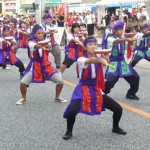
August 8, 2011 Ryukyu Shimpo
“Ten thousand people Eisa Dance Parade” of the Summer Festival in Naha 2011, in which members of Youth Groups and Eisa groups from various parts of the prefecture took part in a vibrant dance performance, was held at Kokusai Street in Naha City on August 7.
Despite cloudy skies and a strong wind due to the after effects of Typhoon No.9, about 6000 participants from about 90 groups as well as independent participants took part in a boisterous parade down the street.
According to the event organizer, a total of 90000 visitors enjoyed the parade.
Twenty-three special participants, children of Okinawan emigrants, who were in Okinawa on the Okinawa Junior Study Tour, the pre-event of the 5th Worldwide Uchinanchu Festival, performed Eisa that they had practiced everyday since their arrival in the prefecture.
Smiling 14 year-old Jouji Oshiro, a first-year high school student from Bolivia, said, “I was thrilled to perform Eisa in front of the people of Okinawa. I hope that the 5th Worldwide Uchinanchu Festival provides an opportunity for everyone to share the feelings of Okinawa with each other.”
(English Translation by T&CT, Mark Ealey)
Go To Japanese

Go To Video

August 7, 2011 Ryota Shimabukuro of Ryukyu Shimpo
More than 100 veterans who were stationed on the United States military bases in Okinawa during the 1960s and 1970s have claimed compensation from the United States Department of Veterans Affairs (VA) for damage to their health caused by exposure to a highly toxic defoliant containing dioxin. These men had worked spraying, storing and transporting the defoliants.
According to VA official documents, an Air Force veteran and others who were stationed in Okinawa in the past sought government acknowledgment that their health problems were caused by the toxic defoliant. The documents suggested that the highly toxic defoliant had been used extensively in up to eight facilities in Okinawa, and that it had caused serious health hazards to those involved in its spraying, storage and transport.
With regard to damage caused by the toxic defoliant used by the U.S. Forces on Okinawa, only one case has been reported in 1998 in which the Department of Veterans Affairs approved a claim that there was a connection with prostate cancer suffered by a former U.S. military personnel member who used the highly toxic defoliant in the Northern Training Area during his term of duty in Okinawa.
During the Vietnam War, from 1960 to 1975, the U.S. military used aerial spraying of toxic defoliants, causing child birth defects, miscarriages, and cardiovascular and skin diseases among the local Vietnamese people. Toxic defoliant has a long residual period because it does not break down easily in nature, so there is still an ongoing issue of soil contamination in Vietnam.
Joe Sipala, a 61 year-old U.S. military veteran living in North Carolina, worked at the Awase communication site in 1970. Once a week he sprayed the defoliant called “Agent Orange” on about 55 hectares of land surrounding the site and two hectares around the fence once every two weeks when directed to by his superiors, to secure clear vision for monitoring the approach of potential intruders into the facility. He claims that this work caused his diabetes and skin disease.
According to Department of Veterans Affairs documents, Agent Orange was sprayed, stored and transported at other facilities in Okinawa in addition to the communication site, including Naha military port, the Northern Training Area, Camp Schwab, Kadena Air Base, White Beach, Tengan Pier and Futenma Air Station, and veterans who worked at such facilities have made claims regarding health difficulties due to exposure to this toxic material.
British journalist Jon Mitchell, who has continued to cover the Agent Orange issue, also stated that veterans gave testimony that this defoliant was used and stored at Camp Kuwae, Camp Zukeran and Camp Kinser.
(English Translation by T&CT, Mark Ealey)
Go To Japanese
















 Webcam(Kokusai Street)
Webcam(Kokusai Street)


